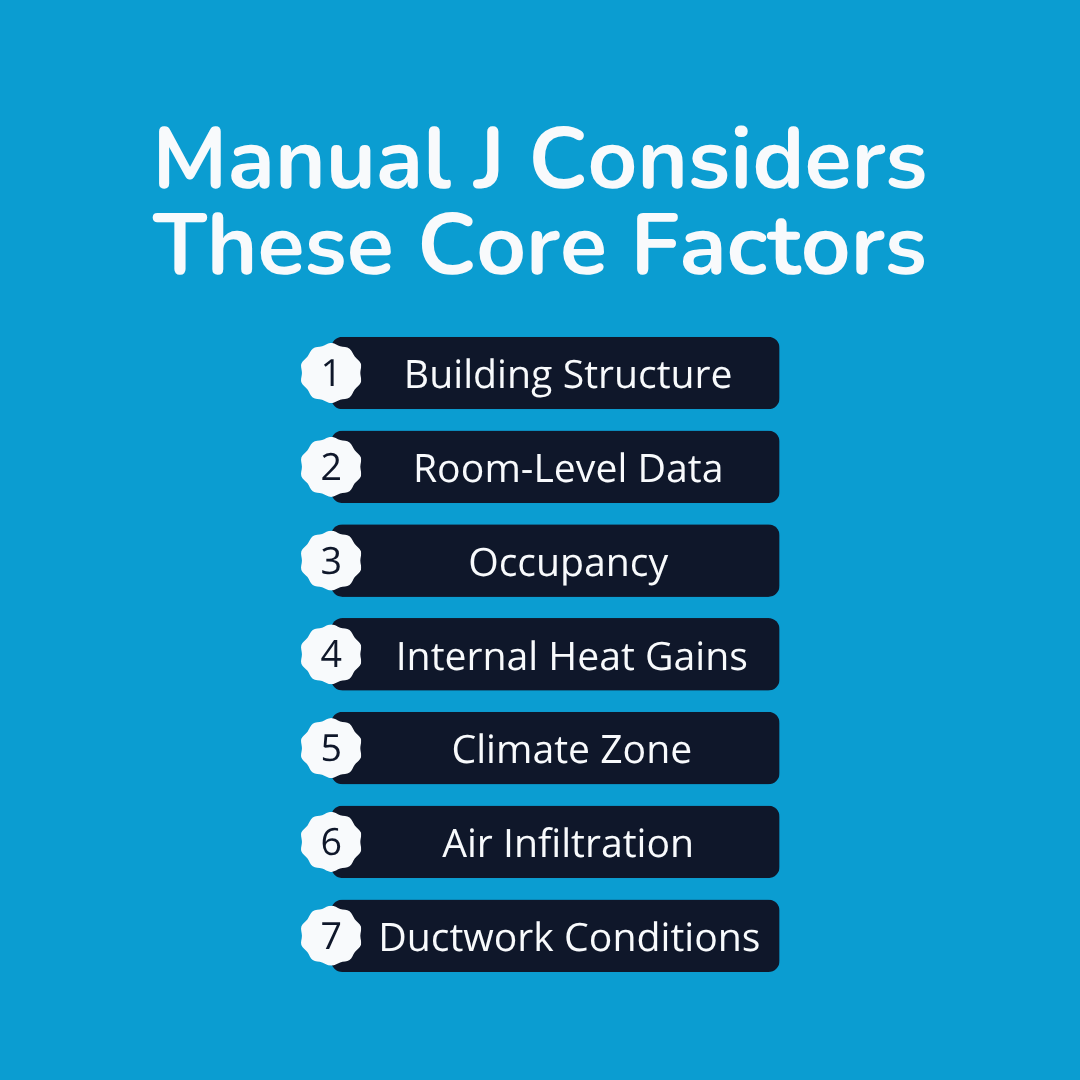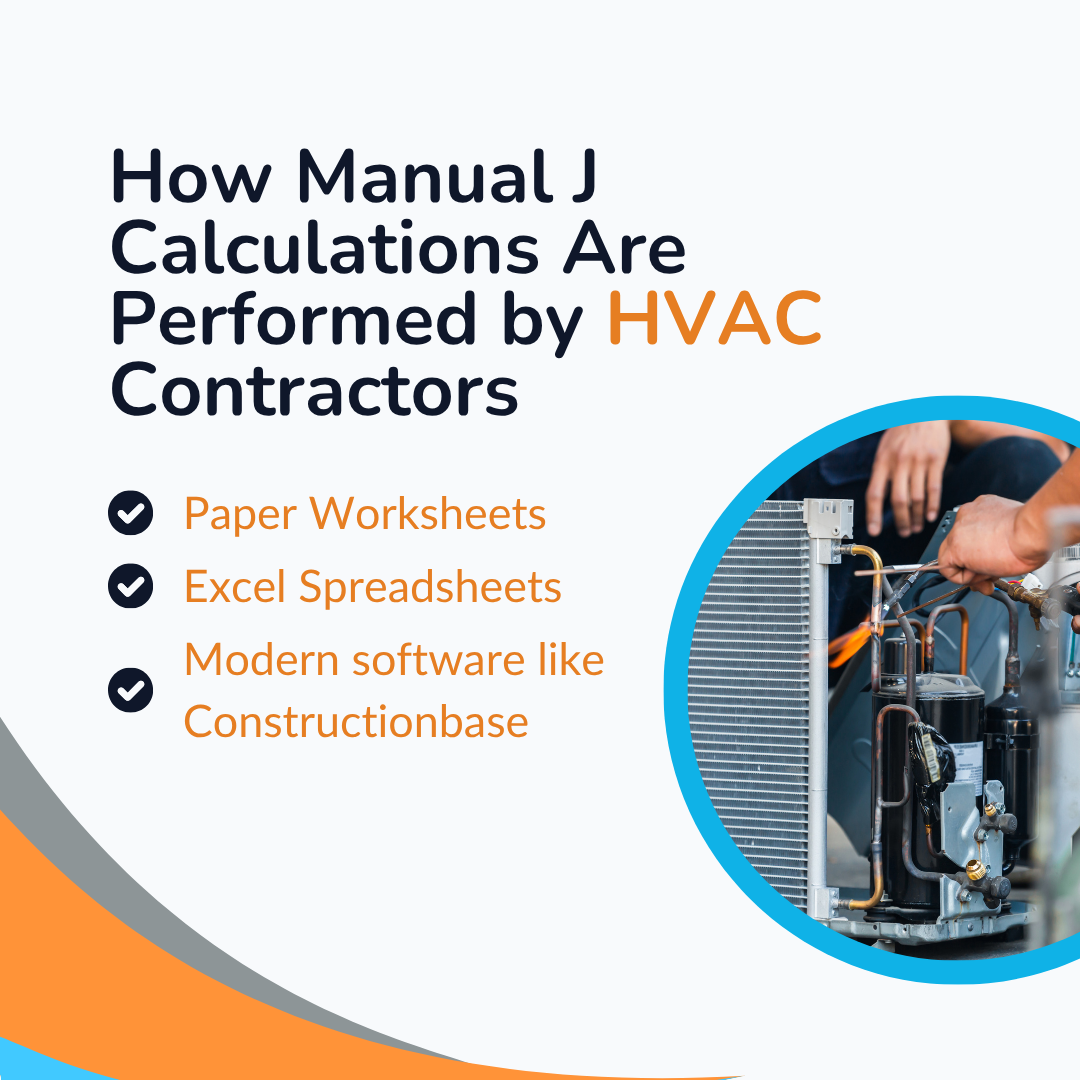What Is Manual J in HVAC & Why It Matters
Audio overview: Listen & Learn
If you're an HVAC contractor, designer, or estimator, understanding what exactly Manual J is can mean the difference between a call-back and a referral. Created
by the Air Conditioning Contractors of America (ACCA), Manual J is the gold standard for residential load calculation.
It tells you exactly how much heating and cooling is needed in each room in a house, based on real-world data like insulation, square footage, windows, ductwork, and even sun exposure.
From equipment size to air distribution and BTU values, this guide will walk you through the essentials of Manual J. So, let’s dive in.
What Is Manual J in HVAC and Why Is It Important
Manual J is the official residential load calculation manual developed by the Air Conditioning Contractors of America (ACCA). It’s used to determine the correct size of HVAC equipment for residential homes based on real data and not guesswork.
A Manual J load calculation considers square footage, windows, insulation, duct system, air distribution, ceiling height, sun exposure, and even external factors such as heat loss, auxiliary heat, and blower door tests.
From BTU values to cooling load, it’s how pros size the HVAC unit, choose the right equipment, and ensure a well-designed HVAC system.
It’s the first step before Manual D, equipment selection manuals, and duct design that is key for new construction and any project needing consistent comfort and energy savings.
Key Takeaways
- Manual J ensures HVAC systems are right-sized for comfort, efficiency, and long-term performance.
- It replaces outdated guesswork with precision, using real-world data like sun exposure and insulation.
- Manual J is the foundation for all HVAC design protocols, and Manuals S, D, and T depend on it.
- Skipping Manual J leads to oversized systems, wasted energy, and dissatisfied customers.
What Is Manual J?
Manual J is the gold standard for HVAC load calculations in single-family homes and small residential buildings.
Developed by the Air Conditioning Contractors of America (ACCA), it offers the most precise method to determine heating and cooling loads based on the unique characteristics of each property.
Unlike outdated “rules of thumb” that rely solely on square footage, Manual J's calculations consider insulation, windows, sun exposure, duct system, ceiling height, and more to size your HVAC system correctly.
Why It Exists:
- To eliminate guesswork in HVAC sizing
- To ensure compliance with energy codes and standards
- To serve as the foundation for other HVAC protocols like Manual S (equipment selection), Manual D (duct design), and Manual T (air distribution)
Manual J is the first step toward a well-designed, efficient HVAC system.
The Manual J Mindset For Your HVAC Equipment
Designing an HVAC system without Manual J is like tailoring a suit without measurements. Manual J load calculation replaces guesswork with precision-engineered sizing.
Rather than relying on square footage or generic HVAC unit types, it considers multiple factors such as insulation, duct design, BTU values, ceiling height, sun exposure, and blower door test results.
Manual J shifts projects away from:
- Oversizing “just in case”
- Uniform sizing across varying climates
- Ignoring key external factors
And moves them toward:
- Room-by-room HVAC load calculation
- Right-sized equipment using exact BTU values
- A well-designed HVAC system that performs efficiently, aligns with ACCA Manual standards, and meets modern codes
Here's How to Improve Customer Service in HVAC with Management Software.
What are HVAC Load Calculations
Load calculations help determine how much heating or cooling a house needs to stay comfortable year-round. Using the Manual J residential load calculation
manual, HVAC professionals assess more than just square footage.

Manual J Considers These Core Factors:
- Building Structure: Wall insulation R-values, roof type, windows, exterior doors, and construction plans
- Room-Level Data: Orientation, ceiling height, number of exterior walls, and square footage
- Occupancy: Number of people using the space regularly
- Internal Heat Gains: From lighting, furnaces, heat pumps, other appliances, and electronics
- Climate Zone: Seasonal weather, humidity, and sun exposure
- Air Infiltration: Tightly sealed vs. leaky homes (influences blower door test results)
- Ductwork Conditions: Leakage, friction rate, and overall duct system efficiency
Each factor contributes to the total HVAC load in British Thermal Units (BTUs). It's the number that tells contractors the exact equipment size and type of HVAC unit or air conditioner needed.
Load calculations also support smarter equipment selection, manual decisions, and accurate Manual D duct design for balanced air distribution and steady comfort.
Why Manual J Calculations Matter

Manual J isn’t just a technical requirement; it’s the foundation of a well-designed HVAC system. Without it, contractors risk installing systems that are either too large or too small for the space, leading to inefficient performance and unhappy customers.
1. Precise HVAC Sizing
A properly done Manual J load calculation ensures the system is neither oversized (which leads to short cycling, poor humidity control, and wasted HVAC power) nor undersized (which causes comfort issues and overworked systems). It helps you get the “just right” size for reliable comfort.
2. Improved Energy Efficiency
When your HVAC unit is correctly sized, it runs efficiently, cutting down unnecessary energy use, minimizing on-off cycling, and lowering both operating costs and environmental impact.
3. Foundation of Residential HVAC Design
Manual J is the first step in a system of standardized protocols:
| Protocol | Purpose |
|---|---|
| Manual J Load Calculations (Sizing) | Calculates how much heating or cooling is needed to maintain a comfortable temperature |
| Manual S Equipment Selection | The next step after Manual J is to ensure that the selected equipment can meet the building's heating and cooling demands |
| Manual D Ductwork Design | This manual ensures balanced airflow throughout the home while reducing pressure drops across the duct system. |
| Manual T Register & Grill Placement | It accounts for air velocity, throw, and coverage to deliver consistent comfort, ensuring even temperature distribution while minimizing drafts |
Each relies on accurate Manual J data to function effectively.
4. Compliance & Credibility
Manual J is often required by national codes, local permits, and green certifications. It also boosts your professional credibility with inspectors, clients, and builders alike.
How HVAC Contractors perform Manual J Calculations

Manual J load calculation is the foundation of selecting the right HVAC equipment for residential homes, ensuring proper cooling load, heating, and air distribution. Here's how it's done:
1. Paper Worksheets
Paper worksheets follow the traditional method from the original residential load calculation manual. While useful for teaching fundamentals, they are time-consuming and more prone to human error.
2. Excel Spreadsheets
This method is useful for basic load calculations or standard home models, but offers limited accuracy when dealing with unique builds or room-specific HVAC load.
3. Software (Modern Standard)
Today’s HVAC contractors use ACCA Manual J-certified software to calculate total BTU, Manual J residential loads, and auxiliary heat.
It considers square footage, windows, insulation, heat loss, and external factors.
Also automates error checks, adjusts for construction plans, and generates shareable reports.
This calculation supports Manual S (equipment selection) and Manual D (duct design), ensuring a well-designed HVAC system tailored for every room and building.
Worried about maximizing ROI for your HVAC business with software? Check this out!
Top 3 Manual J Software Solutions
1. HVACBase
Built for HVAC professionals, HVACBase simplifies tool selection by curating and comparing the best Manual J software in the market.
Key Features:
- Offers guides, templates, and checklists for accurate HVAC sizing
- Tracks inventory in real time with low-stock alerts and barcode scanning capability
- Expert-written workflows for Manual J, S, and D
- Offers job scheduling, dispatching, and GPS tracking for efficient workforce management
- Monitor job performance, team productivity, and sales outcomes with intuitive, visual dashboards
Pricing:
- Book a personalized demo here or talk to HVAC experts to learn more about pricing details.
2. CoolCalc
A cloud-based, ACCA-approved platform used by both independent contractors and HVAC businesses.
Key Features:
- Room-by-room and block load calculation capabilities
- Fully mobile-friendly, works in any browser
- Auto-generates compliant reports specifically MJ8 (Manual J) load calculation reports
- Intuitive UI for on-the-go calculations
- Cloud-based platform accessible from any device without software downloads
Pricing:
- The pack offers 4 Manual J reports.
3. Wrightsoft
One of the most established desktop HVAC design suites trusted by engineers and architects.
Key Features:
- Offers advanced load simulations (Manual J/S/D/T)
- Ideal for complex or high-end residential and commercial systems
- Includes 3D visuals and whole-system simulations
- CAD-like workflow
- Syncs seamlessly across Wrightsoft tools
Pricing:
- Annual subscription starts at $500 up to $1100.
How Manual J Connects to Real-World Efficiency

1. Longer System Lifespan
Manual J load calculations ensure the HVAC system is properly sized, preventing short cycling and wear. The Result: fewer repairs and better returns.
2. Consistent Comfort
Right-sized HVAC equipment delivers even heating and cooling. No more hot or cold rooms, just balanced airflow.
3. Predictable Energy Bills
Systems run at peak efficiency, avoiding overuse of power and keeping HVAC load costs stable.
4. Better Bids and Proposals
With Manual J, HVAC contractors create precise, trustworthy bids, reduce change orders, and gain homeowner confidence.
When Should You Use Manual J?
Manual J should be used always, but especially for:
- New residential construction
- Major remodels
- HVAC replacements
- High-performance homes
- Projects seeking energy efficiency credits or green certifications
Even for repeat floor plans, re-run the Manual J load calculation if there’s any change in location, sun orientation, or building materials.
Small differences and several factors can shift the total HVAC load and affect equipment selection and overall system efficiency.
A must-read: A Complete Guide to HVAC Project Management Software for 2025
Common Myths About Manual J
Myth 1: “I’ve sized HVAC systems like this for 20 years.”
Truth: What worked in 2005 won’t meet today’s standards. Modern residential homes are more insulated, climate zones are shifting, and comfort demands are higher. A Manual J load calculation ensures the right equipment for today’s conditions.
Myth 2: “Manual J oversizes the HVAC unit.”
Truth: Manual J doesn’t guess; it calculates. If results seem off, revisit inputs like square footage, windows, or insulation. A wrong BTU value means the wrong HVAC equipment.
Myth 3: “Manual J takes too long.”
Truth: With modern Manual J software, it’s quick. Simply plug in your construction plans to get precise HVAC load data, enabling smarter equipment selection, proper duct design, and a well-designed HVAC system.
What Happens If You Skip Manual J
Skipping a Manual J load calculation might feel like a shortcut, but it leads to costly long-term consequences.
Without accurate HVAC load data, you risk installing oversized systems that come with higher upfront costs, poor dehumidification, and uneven air distribution.
An undersized HVAC unit can’t keep up, leading to customer discomfort, complaints, and costly callbacks.
You may also face code violations, failed inspections, and missed energy efficiency incentives. Worse, you lose your edge over HVAC contractors who provide precise, well-designed HVAC systems using Manual J.
Manual J isn’t extra work; it’s smart business. It protects your reputation, ensures correct equipment sizing, and delivers consistent heating and cooling that builds trust and boosts referrals.
How HVACBase Helps with Manual J and HVAC Design
At HVACBase, we empower HVAC professionals to achieve precision in load calculation, equipment sizing, and system design, all streamlined within one integrated platform.
Built for HVAC precision:
- Perform Manual J, S, and D compliant calculations using square footage, insulation values, sun exposure, orientation, and more.
- Generate ideal BTU values, equipment specs, and duct system recommendations automatically.
Tools & Templates for speed and accuracy:
- Customizable proposal and load calculation templates reduce manual effort.
- Interactive design tools let you adjust insulation or window specs and immediately see load implications, and no guesswork.
Professional, permit-ready output:
- Deliver branded, permit-ready PDFs that inspectors and clients trust.
Anywhere access with integrated workflows:
- Work seamlessly from the field or the office as real-time sync ensures your data stays connected across mobile and desktop environments.
- Automatically pull customer and job data from CRM, attach the design to a proposal, and convert it to a scheduled job, all with zero duplicate entry.
HVACBase delivers smarter HVAC system design that balances speed, accuracy, and professionalism so that load calculation becomes a competitive advantage, not a hurdle.
Bringing It All Together
Manual J isn’t just about numbers; it’s about delivering comfort, efficiency, and credibility with every HVAC system you design. With over 65% of new systems underperforming due to improper sizing or installation, embracing accurate HVAC load calculations isn’t optional; it’s essential.
From new construction to high-performance homes, Manual J lays the foundation for right-sized equipment, balanced airflow, and fewer callbacks.
So, pair that precision with platforms like HVACBase, and you’re not just following standards, you’re setting them.
About HVACBase
HVACBase isn’t just another piece of software—it’s an integrated business hub tailored for HVAC professionals. It helps HVAC pros simplify load calculations, streamline workflows, and grow their HVAC business with smart, integrated tools.
Ensure your HVAC systems are sized and installed for peak performance—schedule a demo with HVACBase!
FAQs
1. What does a Manual J do?
Manual J is a residential load calculation manual used to determine the total HVAC load of a house. It calculates the right HVAC equipment size based on several factors like square footage, insulation, sun exposure, and windows.
2. What is the difference between Manual J and S?
Manual J focuses on HVAC load calculation, determining how much heating and cooling a home needs. Manual S follows up with equipment selection, ensuring your HVAC unit meets BTU values for optimal performance.
3. Do I really need a Manual J load calculation?
Yes. A Manual J ensures your HVAC system is correctly sized, avoiding oversized air conditioners or undersized heat pumps. It prevents excessive energy use and improves your air distribution and duct system efficiency.
4. What does a Manual J cost?
Manual J calculation costs vary, generally starting from 15$, depending on house size and complexity. HVAC contractors use it for accurate BTU-based estimates, ensuring a well-designed HVAC system tailored to your home.
Have questions or need personalized advice?
Talk to an Expert Today and let our construction specialists guide you to success.






